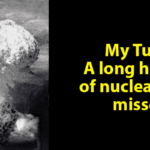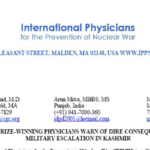By Noel Wauchope | 17 August 2019
There are several reasons why it would be a bad idea for Australia to jump aboard the bandwagon of small modular reactors, writes Noel Wauchope.
SMALL MODULAR REACTORS are in the news internationally and, rather more quietly, also in Australia.
International news reports that, in a failed missile test in Russia, a small nuclear reactor blew up, killing five nuclear scientists and releasing a radiation spike.
In Australian news, with considerably less media coverage, Parliament announced an Inquiry into nuclear energy for Australia, with an emphasis on small modular reactors (SMRs). Submissions are due by 16 September.
A bit of background. The U.S. Government and the U.S. nuclear industry are very keen to develop and export small modular nuclear reactors for two main reasons, both explained in the Proceedings of the National Academy of Sciences 2018. Firstly, with the decline of large nuclear reactors, there is a need to maintain the technology and the expertise of trained staff necessary to support the nuclear weapons industry. Secondly, the only hope for commercial viability of small nuclear reactors is in exporting them — the domestic market is too small. So, Australia is seen as a desirable market.
The USA motivation for exporting these so far non-existent prefabricated reactors is clear. The motivation of their Australian promoters is not so clear.
Here are the main reasons why it would be a bad idea for Australia to import small modular nuclear reactors:
1. Cost
Researchers from Carnegie Mellon University’s Department of Engineering and Public Policy concluded that the SMR industry would not be viable unless the industry received ‘several hundred billion dollars of direct and indirect subsidies’ over the next several decades. For a company to invest in a factory to manufacture reactors, they’d need to be sure of a real market for them — Australia would have to commit to a strong investment up front.
The diseconomics of scale make SMRs more expensive than large reactors. A 250 MW SMR will generate 25 per cent as much power as a 1,000 MW reactor, but it will require more than 25 per cent of the material inputs and staffing and a number of other costs including waste management and decommissioning will be proportionally higher.
A study by WSP/Parsons Brinckerhoff, commissioned by the 2015/16 South Australian Nuclear Fuel Cycle Royal Commission, estimated costs of A$180?184/MWh (US$127?130) for large pressurised water reactors and boiling water reactors, compared to A$198?225 (US$140?159) for SMRs.
To have any hope of being economically viable, SMRs would have to be mass-produced and deployed and here is a catch-22 problem — the economics of mass production of SMRs cannot be proven until hundreds of units are in operation. But that can’t happen unless there are hundreds of orders and there will be few takers unless the price can be brought down. Huge government subsidy is therefore required.
2. Safety problems
Small nuclear reactors still have the same kinds of safety needs as large ones have. The heat generated by the reactor core must be removed both under normal and accident conditions, to keep the fuel from overheating, becoming damaged and releasing radioactivity. The passive natural circulation cooling could be effective under many conditions, but not under all accident conditions.
For instance, for the NuScale design, a large earthquake could send concrete debris into the pool, obstructing circulation of water or air. Where there are a number of units, accidents affecting more than one small unit may cause complications that could overwhelm the capacity to cope with multiple failures.
Because SMRs have weaker containment systems than current reactors, there would be greater damage if a hydrogen explosion occurred. A secondary containment structure would prevent large-scale releases of radioactivity in case of a severe accident. But that would make individual SMR units unaffordable. The result? Companies like NuScale now move to projects called “medium” nuclear reactors, with 12 units under a single containment structure. Not really small anymore.
Underground siting is touted as a safety solution, to avoid aircraft attacks and earthquakes. But that increases the risks from flooding. In the event of an accident emergency, crews could have greater difficulty accessing underground reactors.
3. Security
Proponents of SMRs argue that they can be deployed safely both as a fleet of units close to cities or as individual units in remote locations. In all cases, they’d have to operate under a global regulatory framework, which is going to mean expensive security arrangements and a level of security staffing. “Economies of scale” don’t necessarily work when it comes to staffing small reactors. SMRs will need a larger number of workers to generate a kilowatt of electricity than what is required by large reactors. In the case of security staffing, this becomes important both in a densely populated area and in an isolated one.
4. Weapons proliferation
The latest news on the Russian explosion is a dramatic illustration of the connection between SMRs and weapons development.
But not such a surprise. SMRs have always had this connection, beginning in the nuclear weapons industry in powering U.S. nuclear submarines. They were used in the UK to produce plutonium for nuclear weapons. Today, the U.S. Department of Energy plans to use SMRs as part of “dual use” facilities, civilian and military.
SMRs contain radioactive materials and produce radioactive wastes which could be taken or used part of the production of a “”dirty bomb”. The Pentagon’s Project Dilithium’s small reactors may run on Highly Enriched Uranium (HEU) – nuclear weapons fuel – increasing these risks.
It is now openly recognised that the nuclear weapons industry needs the technology development and the skilled staff that are provided by the “peaceful” nuclear industry. The connection is real, but it’s blurred. The nuclear industry needs the respectability that is conferred by new nuclear, with its claims of safe, clean, climate-solving energy.
5. Wastes
SMRs are designed to produce less radioactive trash than current reactors. But they still produce long-lasting nuclear wastes, and, in fact, for SMRs this is an even more complex problem. Australia already has the problem of spent nuclear fuel waste, accumulating in one place from the nuclear reactor at Lucas Heights. With SMRs adopted, the waste would be located in many sites, with each location having the problem of transport to a disposal facility. Final decommissioning of all these reactors would compound this problem. In the case of underground reactors, there’d be further difficulties with waste retrieval and site rehabilitation.
6. Location
I have touched on this in the paragraphs on safety, security and waste problems. The nuclear enthusiasts are excited about the prospects for small reactors in remote places. After all, aren’t some isolated communities already having success with small, distributed solar and wind energy? It all sounds great, but it isn’t.
With Australia’s great distances, it would be difficult to monitor and ensure the security of such a potentially dangerous system, of many small reactors scattered about on this continent. Nuclear is an industry that is already struggling to attract qualified staff, with a large percentage of skilled workers nearing retirement. The logistics of operating these reactors, meeting regulatory and inspection requirements and maintaining security staff would make the whole thing not just prohibitively expensive, but completely impractical.
7. Delay
For Australia, this has to be the most salient point of all. Economist John Quiggin has pointed out that Australia’s nuclear fans are enthusing about small modular nuclear reactors, but with no clarity on which, of the many types now designed, would be right for Australia. NuScale’s model, funded by the U.S. Government, is the only one at present with commercial prospects, so Quiggin has examined its history of delays. But Quiggin found that NuScale is not actually going to build the factory, it is going to assemble the reactor parts which have been made by another firm — which firm is not clear.
Quiggin concludes:
‘Australia’s proposed nuclear strategy rests on a non-existent plant to be manufactured by a company that apparently knows nothing about it.’
As there’s no market for small nuclear reactors, companies have not invested much money to commercialise them. Westinghouse Electric Company tried for years to get government funding for its SMR plan, then gave up and switched to other projects.
Danny Roderick, then president and CEO of Westinghouse, announced:
“The problem I have with SMRs is not the technology, it’s not the deployment — it’s that there’s no customers. The worst thing to do is get ahead of the market.”
Russia’s programme has been delayed by more than a decade and the estimated costs have ballooned.
South Korea decided on SMRs, but then pulled out, presumably for economic reasons.
China is building one demonstration SMR, but has dropped plans to build 18 more due to diseconomics of the scheme.
There’s a lot of chatter in the international media about all the countries that are interested, or even have signed memoranda of understanding about buying SMRs, but still with no plans for actual purchase or construction.
Is Australia going to be the guinea pig for NuScale’s small and medium reactor scheme? If so, when? The hurdles to overcome would be mind-boggling. The start would have to be the repeal of Australia’s laws: the Environment Protection and Biodiversity Conservation (EPBC) Act 1999 Section 140A and the Australian Radiation Protection and Nuclear Safety Act 1998. Then comes the overcoming of State laws, much political argy-bargy, working out regulatory frameworks, import and transport of nuclear materials, finding locations for siting reactors, Aboriginal issues, community consent and waste locations. And what would it all cost?
In the meantime, energy efficiency developments, renewable energy progress and storage systems will keep happening, getting cheaper and making nuclear power obsolete.


